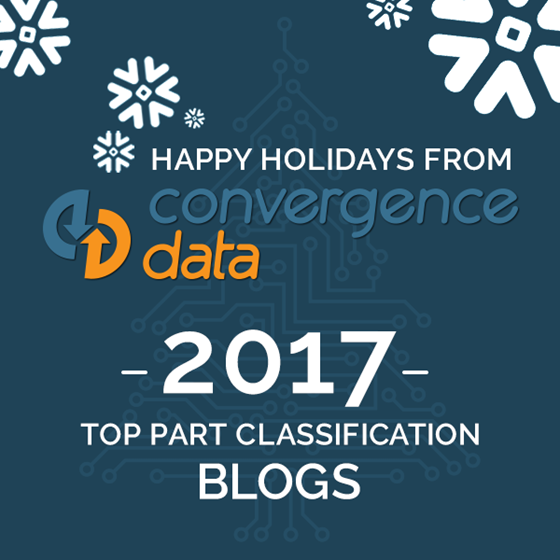2017 Top 5 Part Classification Blogs
Convergence Data knows the importance of your part data. We know that part data is a core asset for your company, and that the quality of that data is fundamental to the health of the business and the bottom line. Start the new year right with a review of the best ways to enrich your data in 2018. Below is a recap of our top five part classification blogs of 2017 ranked by our readers to help you stay on top of your company’s core assets in the new year.
Top 5 Data Quality Blogs:
1) Five Best Practices for Part Classification - Define a classification structure, identify critical attributes, prioritize parts/material to migrate, don’t get hung up on creating the structure (begin with the end in mind), and lastly, leverage resources (smart part numbers, description fields, commodity codes, suppliers, etc.)2) 2 Approaches to Cleansing Data - Do you have good data? Can your engineers and designers quickly find parts to complete their design? Is your part data complete enough to determine if duplicates exist? Are your descriptions consistent and complete enough to sufficiently describe the form and functional specifications of the part? If you answered no, then perhaps it is time to cleanse your data.
3) 3 Approaches to Complexity Reduction - Reducing complexity of your direct material supplier parts can help drive significant savings within your company. Similar to our recently published blog which described the importance of conducting internal price benchmarking activities as a prerequisite to competitive benchmarking on a company’s direct material purchases. In both scenarios it’s surprising what you find when you are able to cleanse and enrich your purchase part data, it can expose a variety of opportunities to reduce direct material spend without having to make major changes to your products. To reduce the complexity, we recommend grouping your direct material spend into these 3 groups...
4) 3 Ways to Attack the #1 Cost Driver - When it comes to controlling costs in business we seldom use the obvious tactics, especially if the solution relies on cross-departmental efforts. It is always easier to control your own department’s costs from within than to gain consensus from other departments. As a result, we default to what we know best, standard department cost reductions. But does this really make the biggest impact for the company?
5) Eight Pitfalls of Creating New Parts! - To develop a product, new parts have to be created. However, sometimes new parts are created which could have been avoided because an existing part could have been used. Creating new parts effects a variety of costs along a product’s lifecycle. Dr. Gwendolyn Galsworth in her book Smart Simple Design provides some insight into the underappreciated consequences of creating unnecessary new parts. Listed are eight pitfalls every engineer and designer should be aware of when creating a new part.
About Convergence Data
Companies with chaotic or incomplete data trust Convergence Data to scrub that information into an organized, efficient structure. The company specializes in:
- Minimizing part duplication
- Cultivating part standardization and re-use
- Reducing part count
- Streamlining inventories
- Improving leverage with vendors
- PLM/ERP migrations
Convergence Data enables customers to manage data in a variety of industries,
including Aerospace and Defense, Appliances, Automotive, Electronics, Industrial Manufacturing, and Oilfield Services.
For companies deploying PLM or ERP solutions, the cleansing, classification, and data enrichment services from Convergence Data can be a significant benefit.
To learn more about Convergence Data and receive a Data Value Analysis (DVA) go to: www.convergencedata.com.


